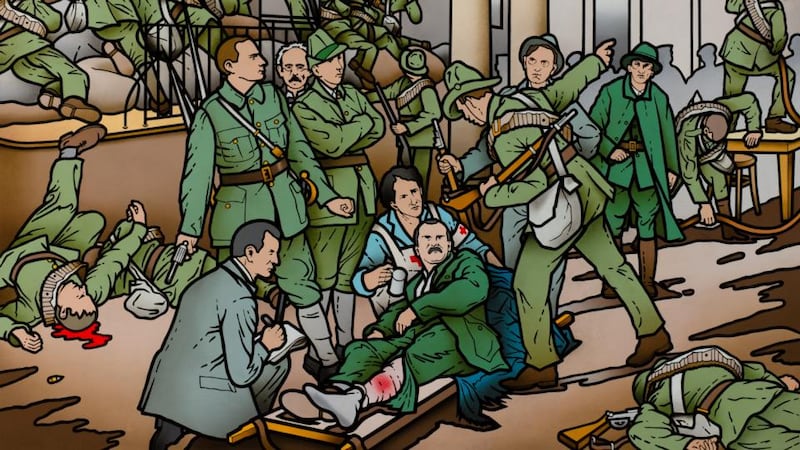In 1916, the artist Kathleen Fox had returned to Dublin after spending time in London and Paris. When the Easter Rising began, she decided to see for herself what was happening in the city.
Encountering crowds of army personnel on St Stephen’s Green, she recognised the woman being arrested outside the College of Surgeons. It was Countess Markievicz, who was second in command of the force occupying the college. Fox immediately did a quick sketch of the scene and later made a painting based on her drawing.
Now in the Niland Collection in Sligo, her painting is exceptional in being an immediate response to the events of Easter week. Equally exceptional, in a different way, is Seán Keating's Men of the West. It depicts three armed men with the Irish tricolour prominent in the background.

Painted in 1915, it anticipated the rebellion to come. The three men depicted are actually the artist himself, his brother and a friend. Their clothing and attitude suggest the American West as much as the Irish West.
When Keating returned to the theme with Men of the South during the War of Independence in 1921, he made a much more realistic, though still dramatic, representation of an IRA "Flying column" in Cork.
An artist who wasn't there and who, furthermore, was English made the most widely reproduced painting of events in the GPO. Walter Paget's Birth of the Irish Republic is a vivid depiction of the interior of the GPO under attack. James Connolly, propped up on a stretcher on the ground, is wounded. Pádraig Pearse and Thomas Clarke direct the defence.
By 1918, Thomas Kiersey of the Eigeas Press had produced a photomechanical engraving of the painting and it has been reproduced in many forms since.
Robert Ballagh based his version of the scene, produced as a limited-edition print to fund the refurbishment of the memorial to the Easter Rising in Glasnevin Cemetery, on Paget’s painting.
For the 50th anniversary of the Rising, in 1966, Thomas Ryan re-imagined the interior of the GPO in a fairly bleak image depicting the embattled volunteers.
Oliver Sheppard originally modelled his sculpture The Death of Cúchulainn in 1911, and it was exhibited in 1914. The mythological embodiment of heroism, nobility and self-sacrifice appealed to Pearse, and in 1912 he wrote that he wanted to "re-create and perpetuate in Ireland the knightly tradition of Cúchulainn".
Official memorial
In 1935, Eamonn de Valera chose Sheppard’s statue as the official memorial to the Rising. It was cast in bronze and installed in the GPO.
Although he was a successful society painter, John Lavery, a Belfast Catholic by birth, had a strong interest in Irish politics, encouraged by his wife, Hazel Martyn.
When the former diplomat and humanitarian Roger Casement was arrested for attempting to smuggle arms into Ireland for use in the Rising, he was charged with treason. The result of his trial in London was regarded as a foregone conclusion, but Lavery decided he would paint the courtroom scene. Through his official connections, he managed to do so, despite adverse comments. The historian Sineád McCoole has written that he continued to work on his painting even after Casement was executed, for the sake of “historical accuracy”.
The Laverys continued their involvement with Ireland, becoming close to Michael Collins. Jack B Yeats did not directly depict the events of the Rising, but he played a central role in shaping the iconography of the emergent nationalist identity. In 1915, he sketched the scene as the body of O'Donovan Rossa, who had edited The United Irishman while in political exile in America, lay in state in Dublin's City Hall.
As early as 1905 The Man from Aranmore established the archetype of the proud, independent man of the west. Exactly that type of figure is visible in Yeats's Men of Destiny, striding purposively in from the shore, in a work painted to mark the 30th anniversary of the Easter Rising in 1946.



















